Project Management Analysis: Lessons from the Deepwater Horizon
VerifiedAdded on 2023/06/11
|11
|2836
|273
Report
AI Summary
This report examines the project management failures that led to the Deepwater Horizon disaster, focusing on the lack of proper supervision, risk management, and communication. It highlights issues with general system management, organizational structure, and portfolio alignment, emphasizing the importance of effective leadership, timely procedures, and comprehensive risk assessment. The analysis reveals that ineffective communication and compartmentalization of information contributed significantly to the disaster, preventing the identification and mitigation of critical risks. The report also discusses the tarnished business value of BP due to the failure to prioritize worker safety and the lack of organizational maturity in providing proper guidance and oversight. The document is contributed by a student and available on Desklib, a platform offering study tools and resources.
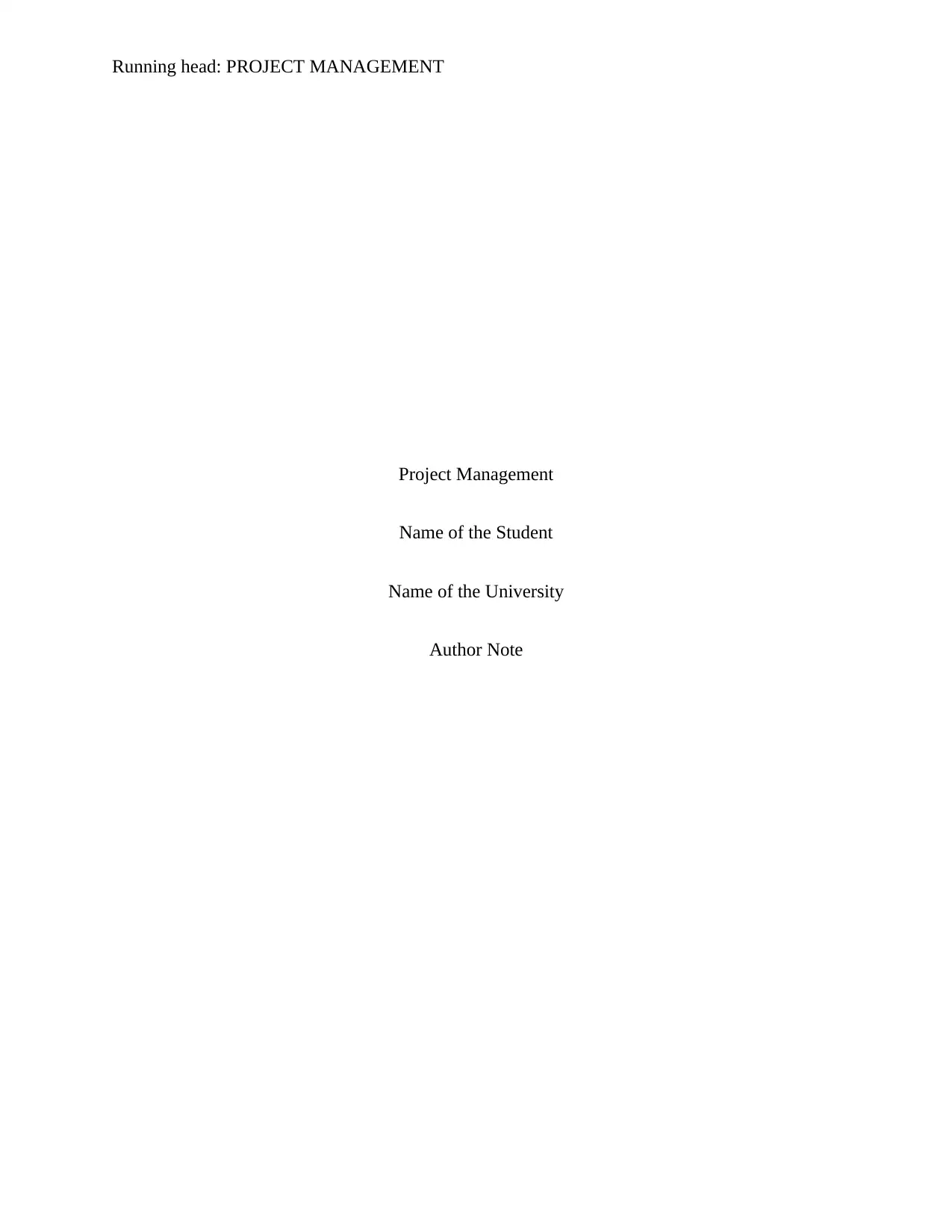
Running head: PROJECT MANAGEMENT
Project Management
Name of the Student
Name of the University
Author Note
Project Management
Name of the Student
Name of the University
Author Note
Paraphrase This Document
Need a fresh take? Get an instant paraphrase of this document with our AI Paraphraser
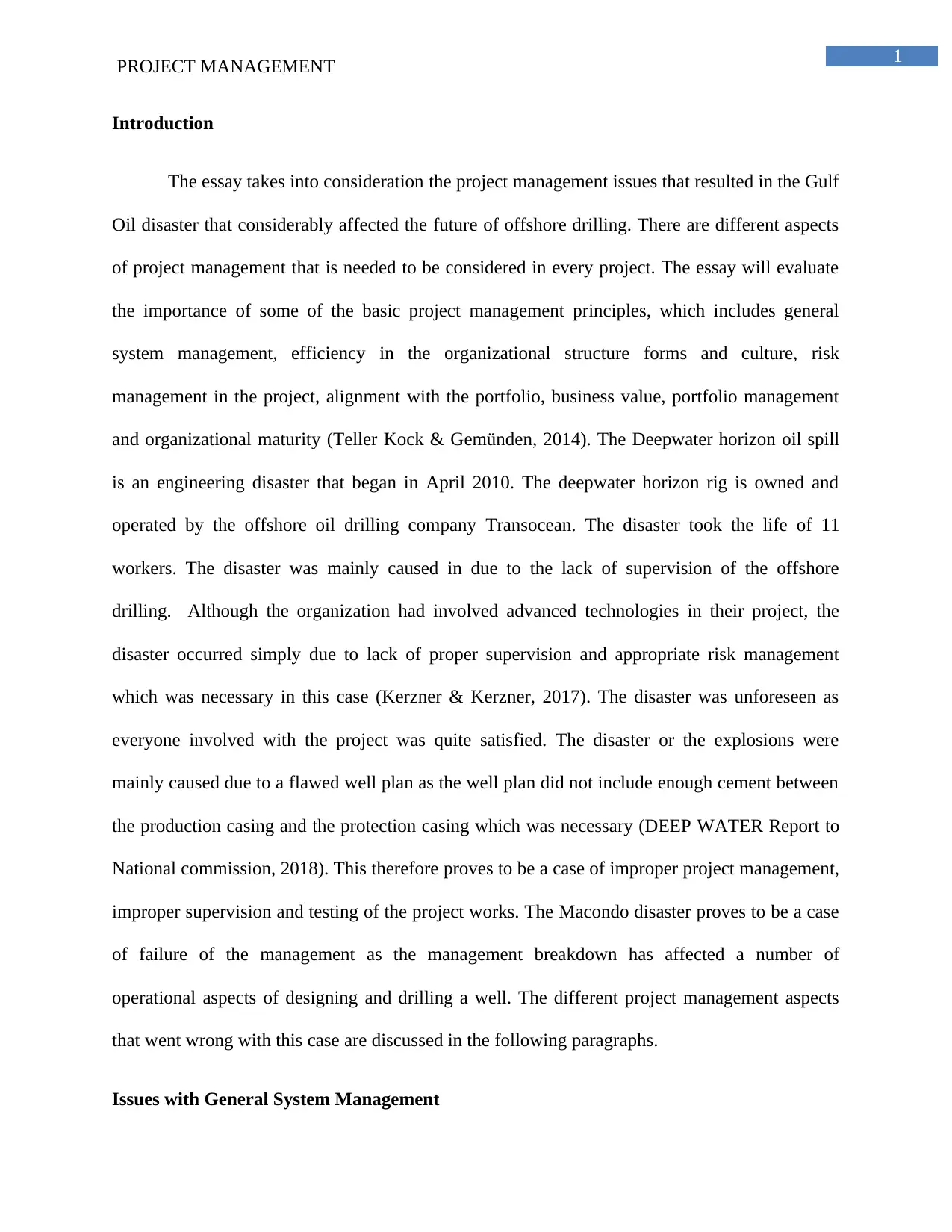
1
PROJECT MANAGEMENT
Introduction
The essay takes into consideration the project management issues that resulted in the Gulf
Oil disaster that considerably affected the future of offshore drilling. There are different aspects
of project management that is needed to be considered in every project. The essay will evaluate
the importance of some of the basic project management principles, which includes general
system management, efficiency in the organizational structure forms and culture, risk
management in the project, alignment with the portfolio, business value, portfolio management
and organizational maturity (Teller Kock & Gemünden, 2014). The Deepwater horizon oil spill
is an engineering disaster that began in April 2010. The deepwater horizon rig is owned and
operated by the offshore oil drilling company Transocean. The disaster took the life of 11
workers. The disaster was mainly caused in due to the lack of supervision of the offshore
drilling. Although the organization had involved advanced technologies in their project, the
disaster occurred simply due to lack of proper supervision and appropriate risk management
which was necessary in this case (Kerzner & Kerzner, 2017). The disaster was unforeseen as
everyone involved with the project was quite satisfied. The disaster or the explosions were
mainly caused due to a flawed well plan as the well plan did not include enough cement between
the production casing and the protection casing which was necessary (DEEP WATER Report to
National commission, 2018). This therefore proves to be a case of improper project management,
improper supervision and testing of the project works. The Macondo disaster proves to be a case
of failure of the management as the management breakdown has affected a number of
operational aspects of designing and drilling a well. The different project management aspects
that went wrong with this case are discussed in the following paragraphs.
Issues with General System Management
PROJECT MANAGEMENT
Introduction
The essay takes into consideration the project management issues that resulted in the Gulf
Oil disaster that considerably affected the future of offshore drilling. There are different aspects
of project management that is needed to be considered in every project. The essay will evaluate
the importance of some of the basic project management principles, which includes general
system management, efficiency in the organizational structure forms and culture, risk
management in the project, alignment with the portfolio, business value, portfolio management
and organizational maturity (Teller Kock & Gemünden, 2014). The Deepwater horizon oil spill
is an engineering disaster that began in April 2010. The deepwater horizon rig is owned and
operated by the offshore oil drilling company Transocean. The disaster took the life of 11
workers. The disaster was mainly caused in due to the lack of supervision of the offshore
drilling. Although the organization had involved advanced technologies in their project, the
disaster occurred simply due to lack of proper supervision and appropriate risk management
which was necessary in this case (Kerzner & Kerzner, 2017). The disaster was unforeseen as
everyone involved with the project was quite satisfied. The disaster or the explosions were
mainly caused due to a flawed well plan as the well plan did not include enough cement between
the production casing and the protection casing which was necessary (DEEP WATER Report to
National commission, 2018). This therefore proves to be a case of improper project management,
improper supervision and testing of the project works. The Macondo disaster proves to be a case
of failure of the management as the management breakdown has affected a number of
operational aspects of designing and drilling a well. The different project management aspects
that went wrong with this case are discussed in the following paragraphs.
Issues with General System Management
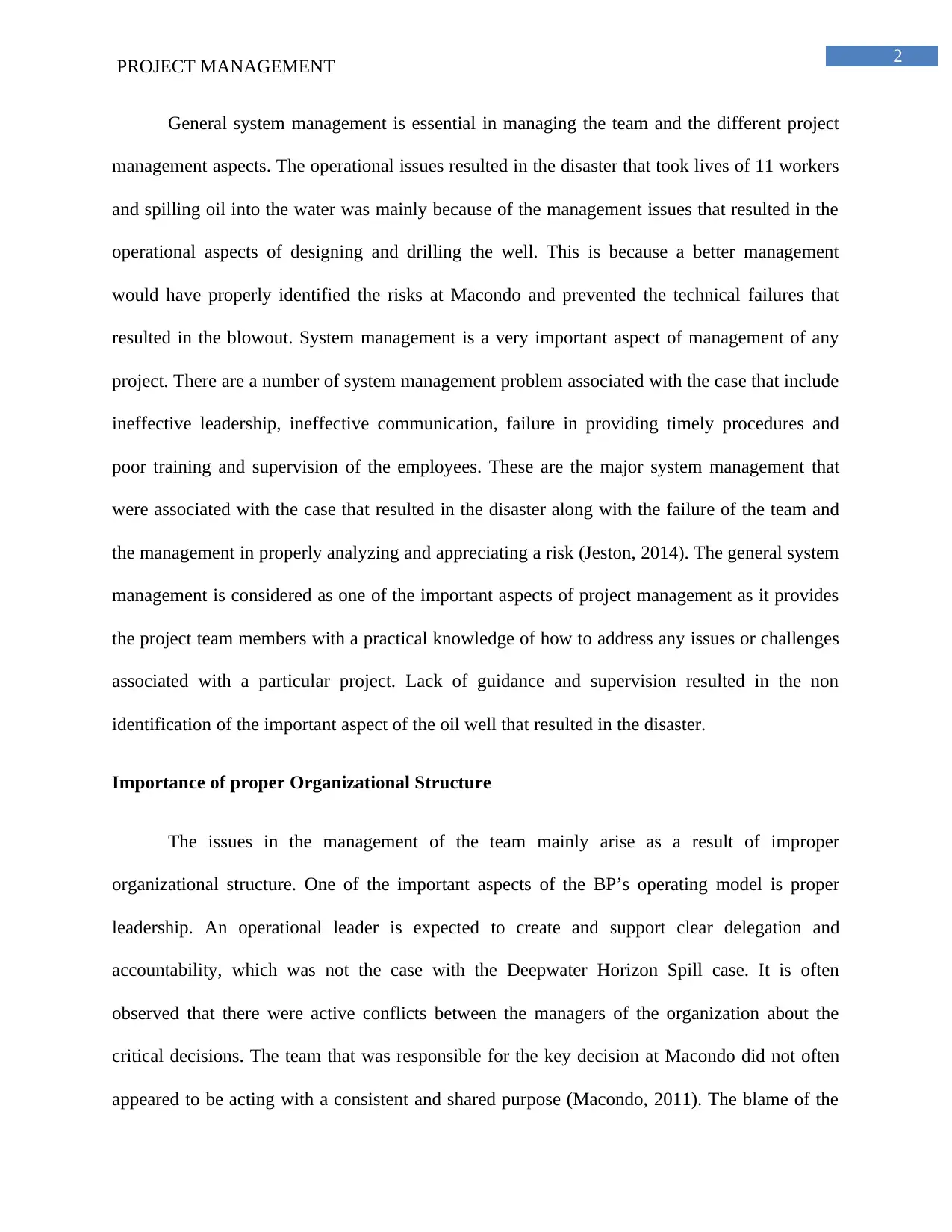
2
PROJECT MANAGEMENT
General system management is essential in managing the team and the different project
management aspects. The operational issues resulted in the disaster that took lives of 11 workers
and spilling oil into the water was mainly because of the management issues that resulted in the
operational aspects of designing and drilling the well. This is because a better management
would have properly identified the risks at Macondo and prevented the technical failures that
resulted in the blowout. System management is a very important aspect of management of any
project. There are a number of system management problem associated with the case that include
ineffective leadership, ineffective communication, failure in providing timely procedures and
poor training and supervision of the employees. These are the major system management that
were associated with the case that resulted in the disaster along with the failure of the team and
the management in properly analyzing and appreciating a risk (Jeston, 2014). The general system
management is considered as one of the important aspects of project management as it provides
the project team members with a practical knowledge of how to address any issues or challenges
associated with a particular project. Lack of guidance and supervision resulted in the non
identification of the important aspect of the oil well that resulted in the disaster.
Importance of proper Organizational Structure
The issues in the management of the team mainly arise as a result of improper
organizational structure. One of the important aspects of the BP’s operating model is proper
leadership. An operational leader is expected to create and support clear delegation and
accountability, which was not the case with the Deepwater Horizon Spill case. It is often
observed that there were active conflicts between the managers of the organization about the
critical decisions. The team that was responsible for the key decision at Macondo did not often
appeared to be acting with a consistent and shared purpose (Macondo, 2011). The blame of the
PROJECT MANAGEMENT
General system management is essential in managing the team and the different project
management aspects. The operational issues resulted in the disaster that took lives of 11 workers
and spilling oil into the water was mainly because of the management issues that resulted in the
operational aspects of designing and drilling the well. This is because a better management
would have properly identified the risks at Macondo and prevented the technical failures that
resulted in the blowout. System management is a very important aspect of management of any
project. There are a number of system management problem associated with the case that include
ineffective leadership, ineffective communication, failure in providing timely procedures and
poor training and supervision of the employees. These are the major system management that
were associated with the case that resulted in the disaster along with the failure of the team and
the management in properly analyzing and appreciating a risk (Jeston, 2014). The general system
management is considered as one of the important aspects of project management as it provides
the project team members with a practical knowledge of how to address any issues or challenges
associated with a particular project. Lack of guidance and supervision resulted in the non
identification of the important aspect of the oil well that resulted in the disaster.
Importance of proper Organizational Structure
The issues in the management of the team mainly arise as a result of improper
organizational structure. One of the important aspects of the BP’s operating model is proper
leadership. An operational leader is expected to create and support clear delegation and
accountability, which was not the case with the Deepwater Horizon Spill case. It is often
observed that there were active conflicts between the managers of the organization about the
critical decisions. The team that was responsible for the key decision at Macondo did not often
appeared to be acting with a consistent and shared purpose (Macondo, 2011). The blame of the
⊘ This is a preview!⊘
Do you want full access?
Subscribe today to unlock all pages.

Trusted by 1+ million students worldwide

3
PROJECT MANAGEMENT
oil spill was mostly on BP as it had announced that it had successfully plugged the oil leak using
a tight cap. The continuous oil leak was to be stopped and the project aimed at stopping the oil
leak. However, due to the lack of proper supervision and testing, a flawed well plan was
implemented that resulted in the explosion and the disaster. As a result of the improper
leadership in the organization, the engineering and the operations were reorganized (Yukl, 2013).
This had resulted in the communication gap and improper project management that resulted in
the disaster.
Importance of Risk Management
Risk management is an important aspect of any project and proper risk management in a
project is essential in order to address the different problems associated with a particular project.
The process of risk management involves identification, evaluation and the prioritization of the
risks so that the identified risk does not have a large effect on the project or organization. One of
the significant facts associated with the Deepwater Horizon case is that the explosion mainly
caused due to a flawed well plan (Loosemore et al., 2012). According to the project management
body of knowledge, risk management is one of the ten major areas about project manager should
acquire a complete knowledge (Rose, 2013). Along with improper project supervision, lack of
proper risk management in the project has resulted in the disaster. The British Petroleum should
have insisted on performing a proper risk management before the implementation of the project
as it was needed to identify the risks associated with the system. The identification of the risks in
the early stages of project implementation is essential in order to mitigate the risk. The risk
management process further involves proper supervision of the risk so that the risk does not
return in the project. The inability of the team of BP in identifying the problem associated with
the design plan proves that the project team did not perform the proper risk management process
PROJECT MANAGEMENT
oil spill was mostly on BP as it had announced that it had successfully plugged the oil leak using
a tight cap. The continuous oil leak was to be stopped and the project aimed at stopping the oil
leak. However, due to the lack of proper supervision and testing, a flawed well plan was
implemented that resulted in the explosion and the disaster. As a result of the improper
leadership in the organization, the engineering and the operations were reorganized (Yukl, 2013).
This had resulted in the communication gap and improper project management that resulted in
the disaster.
Importance of Risk Management
Risk management is an important aspect of any project and proper risk management in a
project is essential in order to address the different problems associated with a particular project.
The process of risk management involves identification, evaluation and the prioritization of the
risks so that the identified risk does not have a large effect on the project or organization. One of
the significant facts associated with the Deepwater Horizon case is that the explosion mainly
caused due to a flawed well plan (Loosemore et al., 2012). According to the project management
body of knowledge, risk management is one of the ten major areas about project manager should
acquire a complete knowledge (Rose, 2013). Along with improper project supervision, lack of
proper risk management in the project has resulted in the disaster. The British Petroleum should
have insisted on performing a proper risk management before the implementation of the project
as it was needed to identify the risks associated with the system. The identification of the risks in
the early stages of project implementation is essential in order to mitigate the risk. The risk
management process further involves proper supervision of the risk so that the risk does not
return in the project. The inability of the team of BP in identifying the problem associated with
the design plan proves that the project team did not perform the proper risk management process
Paraphrase This Document
Need a fresh take? Get an instant paraphrase of this document with our AI Paraphraser
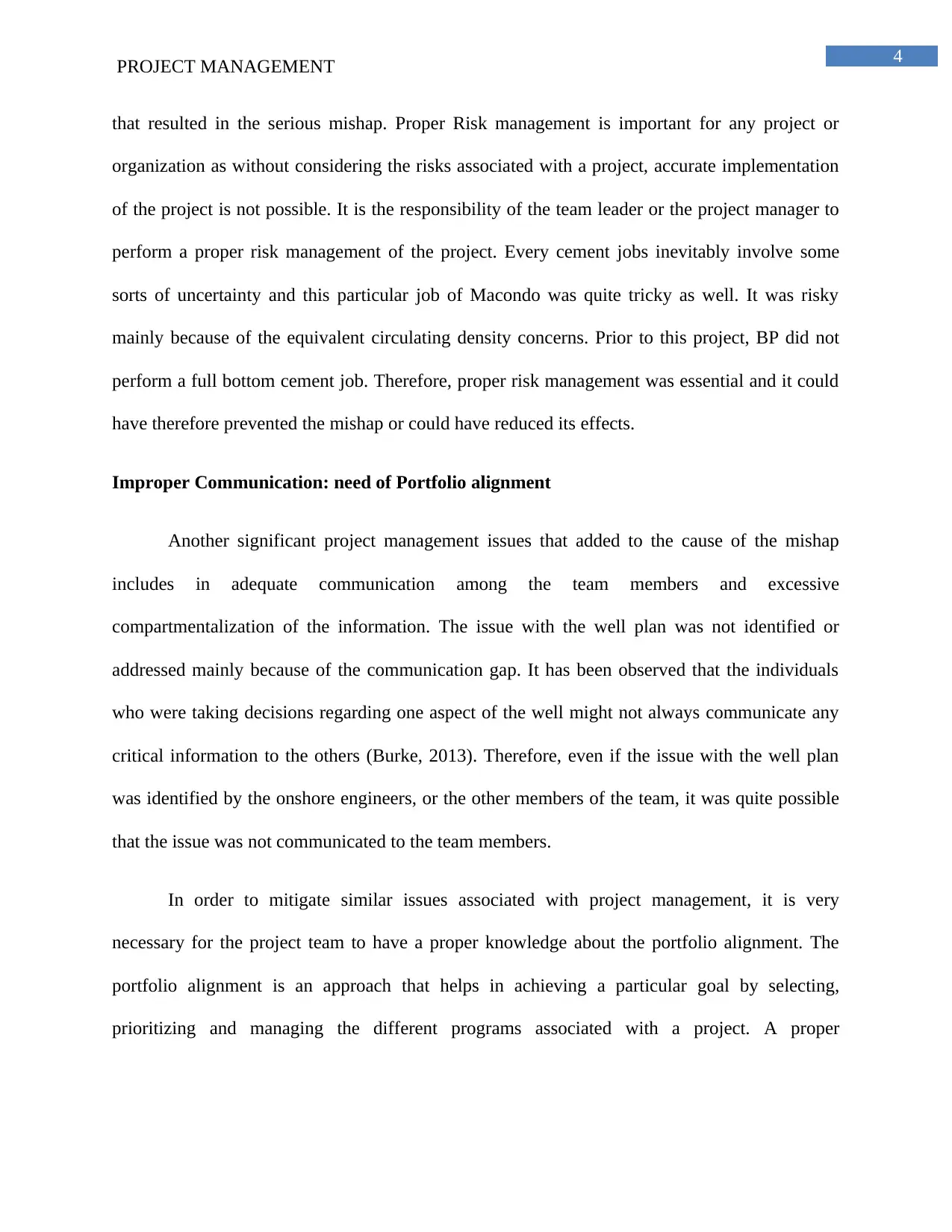
4
PROJECT MANAGEMENT
that resulted in the serious mishap. Proper Risk management is important for any project or
organization as without considering the risks associated with a project, accurate implementation
of the project is not possible. It is the responsibility of the team leader or the project manager to
perform a proper risk management of the project. Every cement jobs inevitably involve some
sorts of uncertainty and this particular job of Macondo was quite tricky as well. It was risky
mainly because of the equivalent circulating density concerns. Prior to this project, BP did not
perform a full bottom cement job. Therefore, proper risk management was essential and it could
have therefore prevented the mishap or could have reduced its effects.
Improper Communication: need of Portfolio alignment
Another significant project management issues that added to the cause of the mishap
includes in adequate communication among the team members and excessive
compartmentalization of the information. The issue with the well plan was not identified or
addressed mainly because of the communication gap. It has been observed that the individuals
who were taking decisions regarding one aspect of the well might not always communicate any
critical information to the others (Burke, 2013). Therefore, even if the issue with the well plan
was identified by the onshore engineers, or the other members of the team, it was quite possible
that the issue was not communicated to the team members.
In order to mitigate similar issues associated with project management, it is very
necessary for the project team to have a proper knowledge about the portfolio alignment. The
portfolio alignment is an approach that helps in achieving a particular goal by selecting,
prioritizing and managing the different programs associated with a project. A proper
PROJECT MANAGEMENT
that resulted in the serious mishap. Proper Risk management is important for any project or
organization as without considering the risks associated with a project, accurate implementation
of the project is not possible. It is the responsibility of the team leader or the project manager to
perform a proper risk management of the project. Every cement jobs inevitably involve some
sorts of uncertainty and this particular job of Macondo was quite tricky as well. It was risky
mainly because of the equivalent circulating density concerns. Prior to this project, BP did not
perform a full bottom cement job. Therefore, proper risk management was essential and it could
have therefore prevented the mishap or could have reduced its effects.
Improper Communication: need of Portfolio alignment
Another significant project management issues that added to the cause of the mishap
includes in adequate communication among the team members and excessive
compartmentalization of the information. The issue with the well plan was not identified or
addressed mainly because of the communication gap. It has been observed that the individuals
who were taking decisions regarding one aspect of the well might not always communicate any
critical information to the others (Burke, 2013). Therefore, even if the issue with the well plan
was identified by the onshore engineers, or the other members of the team, it was quite possible
that the issue was not communicated to the team members.
In order to mitigate similar issues associated with project management, it is very
necessary for the project team to have a proper knowledge about the portfolio alignment. The
portfolio alignment is an approach that helps in achieving a particular goal by selecting,
prioritizing and managing the different programs associated with a project. A proper
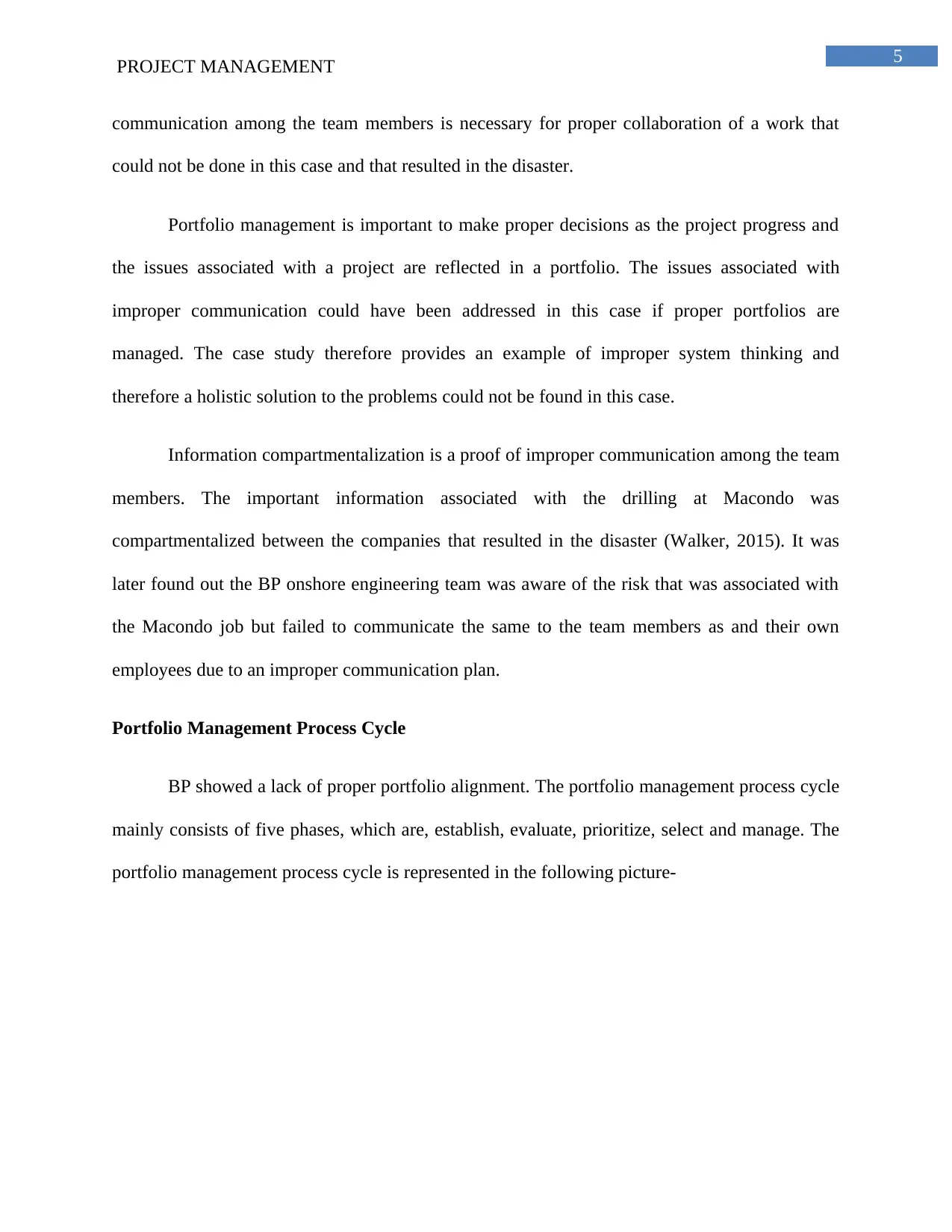
5
PROJECT MANAGEMENT
communication among the team members is necessary for proper collaboration of a work that
could not be done in this case and that resulted in the disaster.
Portfolio management is important to make proper decisions as the project progress and
the issues associated with a project are reflected in a portfolio. The issues associated with
improper communication could have been addressed in this case if proper portfolios are
managed. The case study therefore provides an example of improper system thinking and
therefore a holistic solution to the problems could not be found in this case.
Information compartmentalization is a proof of improper communication among the team
members. The important information associated with the drilling at Macondo was
compartmentalized between the companies that resulted in the disaster (Walker, 2015). It was
later found out the BP onshore engineering team was aware of the risk that was associated with
the Macondo job but failed to communicate the same to the team members as and their own
employees due to an improper communication plan.
Portfolio Management Process Cycle
BP showed a lack of proper portfolio alignment. The portfolio management process cycle
mainly consists of five phases, which are, establish, evaluate, prioritize, select and manage. The
portfolio management process cycle is represented in the following picture-
PROJECT MANAGEMENT
communication among the team members is necessary for proper collaboration of a work that
could not be done in this case and that resulted in the disaster.
Portfolio management is important to make proper decisions as the project progress and
the issues associated with a project are reflected in a portfolio. The issues associated with
improper communication could have been addressed in this case if proper portfolios are
managed. The case study therefore provides an example of improper system thinking and
therefore a holistic solution to the problems could not be found in this case.
Information compartmentalization is a proof of improper communication among the team
members. The important information associated with the drilling at Macondo was
compartmentalized between the companies that resulted in the disaster (Walker, 2015). It was
later found out the BP onshore engineering team was aware of the risk that was associated with
the Macondo job but failed to communicate the same to the team members as and their own
employees due to an improper communication plan.
Portfolio Management Process Cycle
BP showed a lack of proper portfolio alignment. The portfolio management process cycle
mainly consists of five phases, which are, establish, evaluate, prioritize, select and manage. The
portfolio management process cycle is represented in the following picture-
⊘ This is a preview!⊘
Do you want full access?
Subscribe today to unlock all pages.

Trusted by 1+ million students worldwide
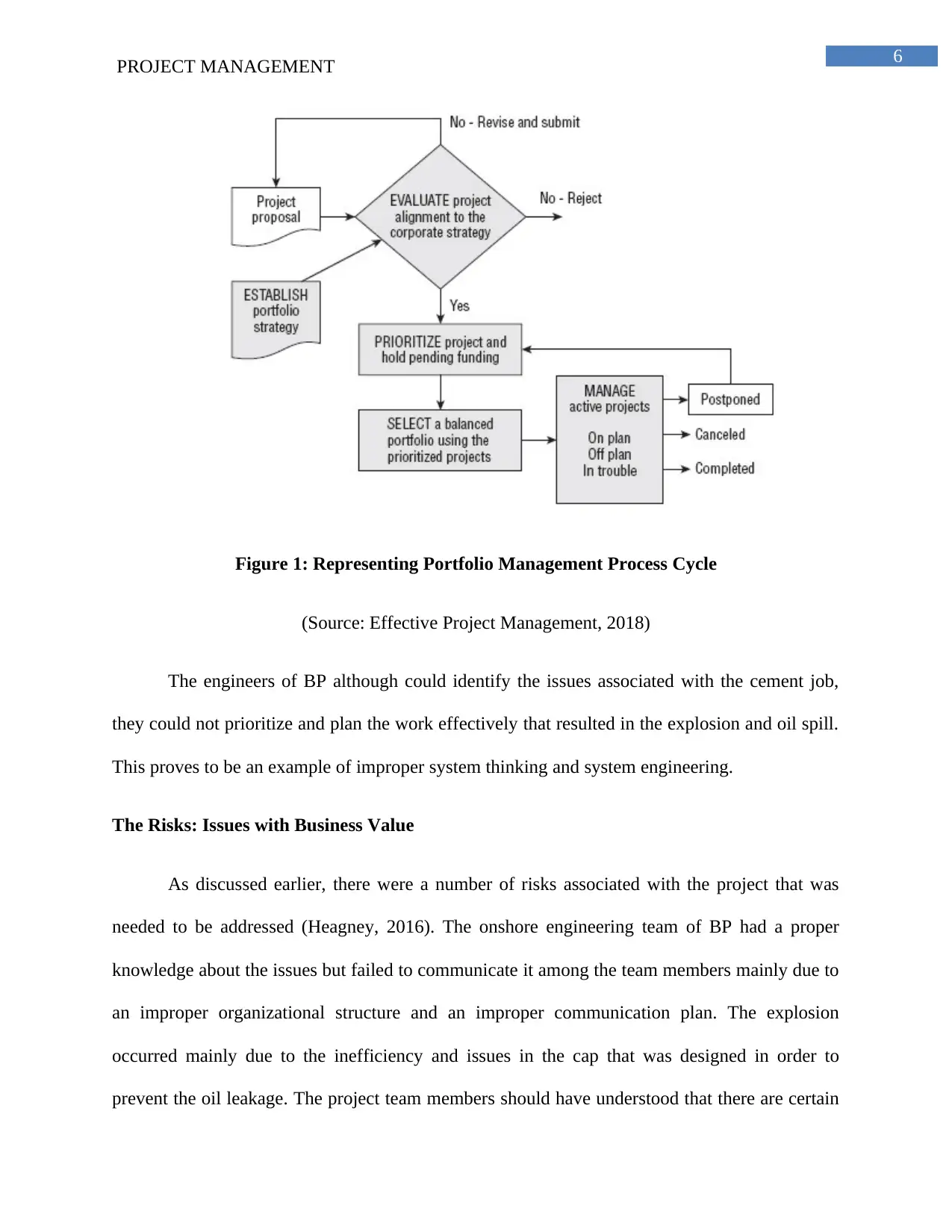
6
PROJECT MANAGEMENT
Figure 1: Representing Portfolio Management Process Cycle
(Source: Effective Project Management, 2018)
The engineers of BP although could identify the issues associated with the cement job,
they could not prioritize and plan the work effectively that resulted in the explosion and oil spill.
This proves to be an example of improper system thinking and system engineering.
The Risks: Issues with Business Value
As discussed earlier, there were a number of risks associated with the project that was
needed to be addressed (Heagney, 2016). The onshore engineering team of BP had a proper
knowledge about the issues but failed to communicate it among the team members mainly due to
an improper organizational structure and an improper communication plan. The explosion
occurred mainly due to the inefficiency and issues in the cap that was designed in order to
prevent the oil leakage. The project team members should have understood that there are certain
PROJECT MANAGEMENT
Figure 1: Representing Portfolio Management Process Cycle
(Source: Effective Project Management, 2018)
The engineers of BP although could identify the issues associated with the cement job,
they could not prioritize and plan the work effectively that resulted in the explosion and oil spill.
This proves to be an example of improper system thinking and system engineering.
The Risks: Issues with Business Value
As discussed earlier, there were a number of risks associated with the project that was
needed to be addressed (Heagney, 2016). The onshore engineering team of BP had a proper
knowledge about the issues but failed to communicate it among the team members mainly due to
an improper organizational structure and an improper communication plan. The explosion
occurred mainly due to the inefficiency and issues in the cap that was designed in order to
prevent the oil leakage. The project team members should have understood that there are certain
Paraphrase This Document
Need a fresh take? Get an instant paraphrase of this document with our AI Paraphraser

7
PROJECT MANAGEMENT
levels of uncertainty associate with any cementing jobs. The equivalent circulating density
concerns added to the risks associated with a cementing job. Since BP did not perform a full
bottom up prior to the cement job, BP made use of foam cement. It pumped a small amount of
cement than the normal and circulated it at much slower flow rates than the normal. BP should
not have pumped the job knowing that there is difficulty in converting the float equipments.
Another mistake that BP did was to rely heavily on its difficult cement job soon after pumping it
by making use of the temporary abundant procedures. All these steps that were undertaken by the
BP team was quite and despite of having a proper knowledge about the associated cementing
related risks, the BP team did not even worked on the negative pressure test. The need of risk
assessment was quite high in this project which was not performed in time and it resulted in the
serious accident. The fact that the BP’s onshore team had a proper knowledge about the risks, it
is evident that the Bp’s onshore team could have easily alerted the well site leaders and the crew
about the most likely cement failure and its associated risks (Hillson & Murray-Webster, 2017).
The failure of doing so proves to be an example of ineffective management and improper
execution of the project (Skogdalen & Vinnem, 2012).
The business value of BP was tarnished to a large extent as a result of the risk mainly
because the team did not consider the heath and well being of the workers working in the firm.
The business value of an organization emphasizes on working honestly in an organization and it
is the responsibility of the team members of a project to put the safety issues of the workers in
the list of priorities, which BP clearly failed to achieve. This is the reason why the business value
of BP was reduced as a result of the project failure.
Lack of Proper Guidance: Issues with Organizational Maturity
PROJECT MANAGEMENT
levels of uncertainty associate with any cementing jobs. The equivalent circulating density
concerns added to the risks associated with a cementing job. Since BP did not perform a full
bottom up prior to the cement job, BP made use of foam cement. It pumped a small amount of
cement than the normal and circulated it at much slower flow rates than the normal. BP should
not have pumped the job knowing that there is difficulty in converting the float equipments.
Another mistake that BP did was to rely heavily on its difficult cement job soon after pumping it
by making use of the temporary abundant procedures. All these steps that were undertaken by the
BP team was quite and despite of having a proper knowledge about the associated cementing
related risks, the BP team did not even worked on the negative pressure test. The need of risk
assessment was quite high in this project which was not performed in time and it resulted in the
serious accident. The fact that the BP’s onshore team had a proper knowledge about the risks, it
is evident that the Bp’s onshore team could have easily alerted the well site leaders and the crew
about the most likely cement failure and its associated risks (Hillson & Murray-Webster, 2017).
The failure of doing so proves to be an example of ineffective management and improper
execution of the project (Skogdalen & Vinnem, 2012).
The business value of BP was tarnished to a large extent as a result of the risk mainly
because the team did not consider the heath and well being of the workers working in the firm.
The business value of an organization emphasizes on working honestly in an organization and it
is the responsibility of the team members of a project to put the safety issues of the workers in
the list of priorities, which BP clearly failed to achieve. This is the reason why the business value
of BP was reduced as a result of the project failure.
Lack of Proper Guidance: Issues with Organizational Maturity

8
PROJECT MANAGEMENT
The lack of proper project management was mainly a result of the inadequate guidance to
the staffs and the onshore team. The BP never provided any adequate guidance to the staffs on
when they should consult onshore personnel. The improper communication plan mainly resulted
in increase in the issues associated with the project. Furthermore, the communication plan did
not address the negative pressures or the criteria that might require a calling shore. Improper
leadership was the reason of improper guidance and it shows and improper organizational
maturity.
Improper organizational maturity resulted in improper management of the complex
engineering system that was associated with the oil well. The oil case of BP therefore provides
an example of improper system engineering.
Conclusion
The report gives an idea of the different project management aspects that went wrong in
the Deep Water case risking the lives of the a number of workers. The disaster caused mainly
because of a flaw in the well plan. The plan did not include enough cement in between the
production casing and protection casing resulting in the disaster. The essay elaborates the
different project management issues associated with this case and evaluates what went wrong
with the project. The issues with general management, organizational structure and leadership
are evaluated in the essay. It is analyzed that improper risk management mainly resulted in the
mishap as risk management is essential for any project. The onshore team could identify the risks
but could not communicate due to the improper communication plan that added to cause of the
disaster.
PROJECT MANAGEMENT
The lack of proper project management was mainly a result of the inadequate guidance to
the staffs and the onshore team. The BP never provided any adequate guidance to the staffs on
when they should consult onshore personnel. The improper communication plan mainly resulted
in increase in the issues associated with the project. Furthermore, the communication plan did
not address the negative pressures or the criteria that might require a calling shore. Improper
leadership was the reason of improper guidance and it shows and improper organizational
maturity.
Improper organizational maturity resulted in improper management of the complex
engineering system that was associated with the oil well. The oil case of BP therefore provides
an example of improper system engineering.
Conclusion
The report gives an idea of the different project management aspects that went wrong in
the Deep Water case risking the lives of the a number of workers. The disaster caused mainly
because of a flaw in the well plan. The plan did not include enough cement in between the
production casing and protection casing resulting in the disaster. The essay elaborates the
different project management issues associated with this case and evaluates what went wrong
with the project. The issues with general management, organizational structure and leadership
are evaluated in the essay. It is analyzed that improper risk management mainly resulted in the
mishap as risk management is essential for any project. The onshore team could identify the risks
but could not communicate due to the improper communication plan that added to cause of the
disaster.
⊘ This is a preview!⊘
Do you want full access?
Subscribe today to unlock all pages.

Trusted by 1+ million students worldwide
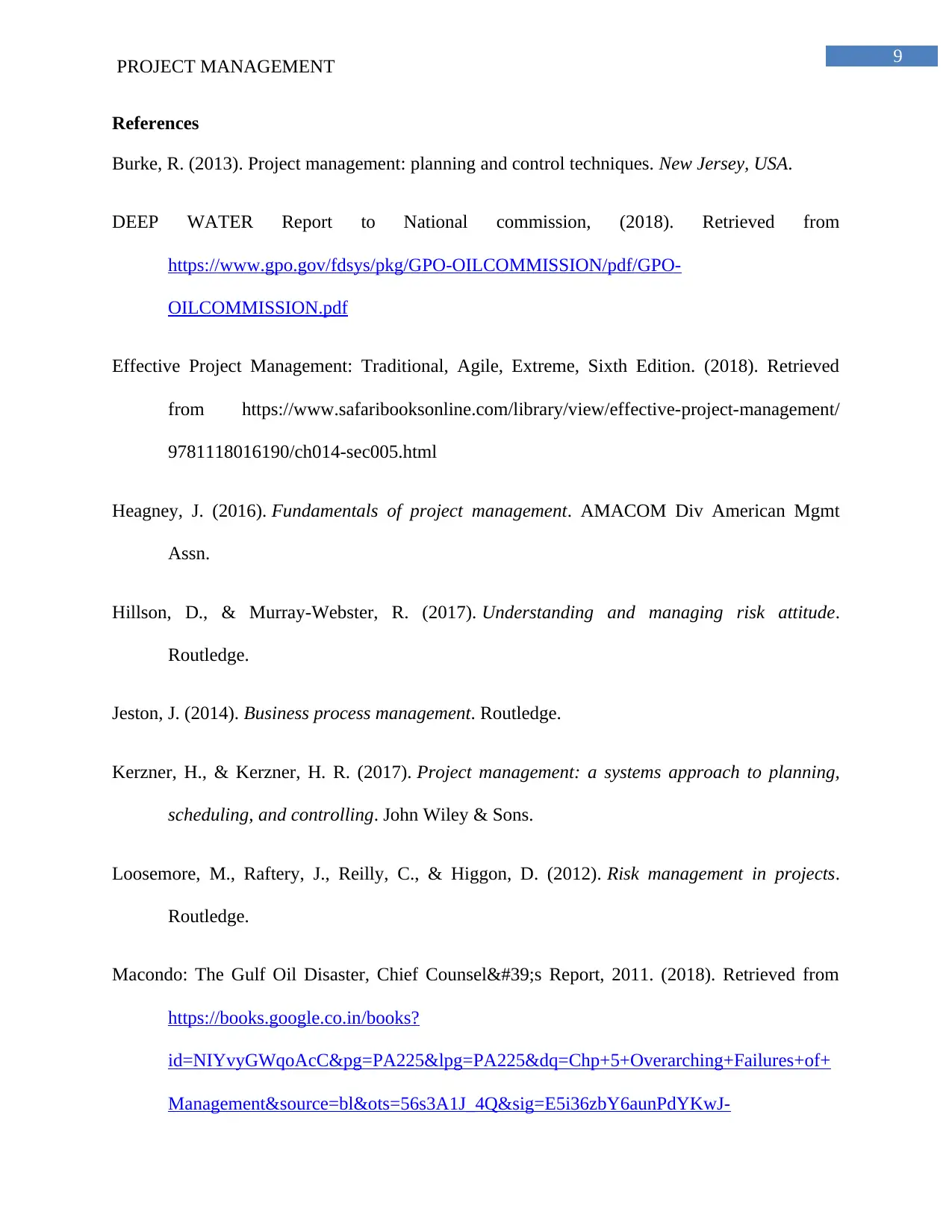
9
PROJECT MANAGEMENT
References
Burke, R. (2013). Project management: planning and control techniques. New Jersey, USA.
DEEP WATER Report to National commission, (2018). Retrieved from
https://www.gpo.gov/fdsys/pkg/GPO-OILCOMMISSION/pdf/GPO-
OILCOMMISSION.pdf
Effective Project Management: Traditional, Agile, Extreme, Sixth Edition. (2018). Retrieved
from https://www.safaribooksonline.com/library/view/effective-project-management/
9781118016190/ch014-sec005.html
Heagney, J. (2016). Fundamentals of project management. AMACOM Div American Mgmt
Assn.
Hillson, D., & Murray-Webster, R. (2017). Understanding and managing risk attitude.
Routledge.
Jeston, J. (2014). Business process management. Routledge.
Kerzner, H., & Kerzner, H. R. (2017). Project management: a systems approach to planning,
scheduling, and controlling. John Wiley & Sons.
Loosemore, M., Raftery, J., Reilly, C., & Higgon, D. (2012). Risk management in projects.
Routledge.
Macondo: The Gulf Oil Disaster, Chief Counsel's Report, 2011. (2018). Retrieved from
https://books.google.co.in/books?
id=NIYvyGWqoAcC&pg=PA225&lpg=PA225&dq=Chp+5+Overarching+Failures+of+
Management&source=bl&ots=56s3A1J_4Q&sig=E5i36zbY6aunPdYKwJ-
PROJECT MANAGEMENT
References
Burke, R. (2013). Project management: planning and control techniques. New Jersey, USA.
DEEP WATER Report to National commission, (2018). Retrieved from
https://www.gpo.gov/fdsys/pkg/GPO-OILCOMMISSION/pdf/GPO-
OILCOMMISSION.pdf
Effective Project Management: Traditional, Agile, Extreme, Sixth Edition. (2018). Retrieved
from https://www.safaribooksonline.com/library/view/effective-project-management/
9781118016190/ch014-sec005.html
Heagney, J. (2016). Fundamentals of project management. AMACOM Div American Mgmt
Assn.
Hillson, D., & Murray-Webster, R. (2017). Understanding and managing risk attitude.
Routledge.
Jeston, J. (2014). Business process management. Routledge.
Kerzner, H., & Kerzner, H. R. (2017). Project management: a systems approach to planning,
scheduling, and controlling. John Wiley & Sons.
Loosemore, M., Raftery, J., Reilly, C., & Higgon, D. (2012). Risk management in projects.
Routledge.
Macondo: The Gulf Oil Disaster, Chief Counsel's Report, 2011. (2018). Retrieved from
https://books.google.co.in/books?
id=NIYvyGWqoAcC&pg=PA225&lpg=PA225&dq=Chp+5+Overarching+Failures+of+
Management&source=bl&ots=56s3A1J_4Q&sig=E5i36zbY6aunPdYKwJ-
Paraphrase This Document
Need a fresh take? Get an instant paraphrase of this document with our AI Paraphraser
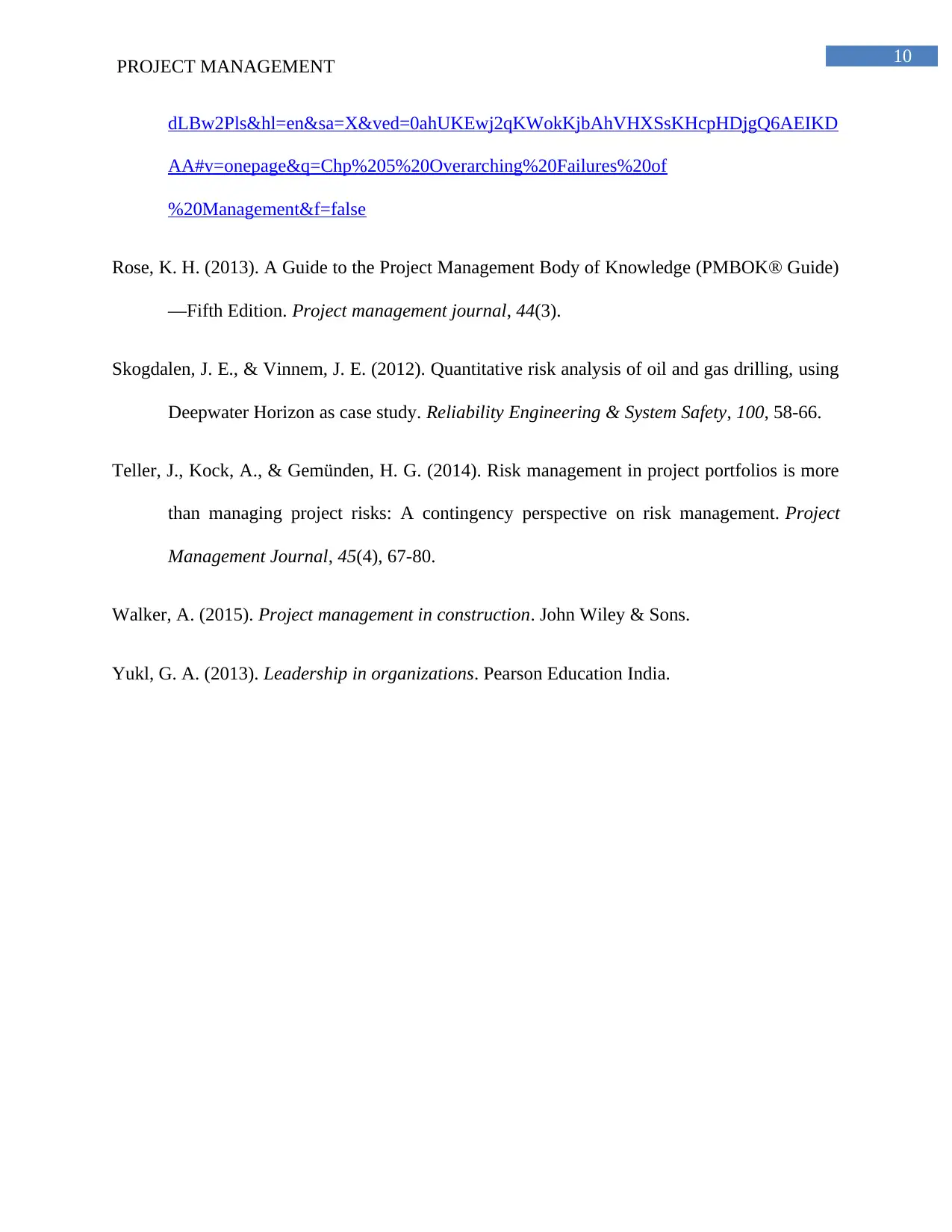
10
PROJECT MANAGEMENT
dLBw2Pls&hl=en&sa=X&ved=0ahUKEwj2qKWokKjbAhVHXSsKHcpHDjgQ6AEIKD
AA#v=onepage&q=Chp%205%20Overarching%20Failures%20of
%20Management&f=false
Rose, K. H. (2013). A Guide to the Project Management Body of Knowledge (PMBOK® Guide)
—Fifth Edition. Project management journal, 44(3).
Skogdalen, J. E., & Vinnem, J. E. (2012). Quantitative risk analysis of oil and gas drilling, using
Deepwater Horizon as case study. Reliability Engineering & System Safety, 100, 58-66.
Teller, J., Kock, A., & Gemünden, H. G. (2014). Risk management in project portfolios is more
than managing project risks: A contingency perspective on risk management. Project
Management Journal, 45(4), 67-80.
Walker, A. (2015). Project management in construction. John Wiley & Sons.
Yukl, G. A. (2013). Leadership in organizations. Pearson Education India.
PROJECT MANAGEMENT
dLBw2Pls&hl=en&sa=X&ved=0ahUKEwj2qKWokKjbAhVHXSsKHcpHDjgQ6AEIKD
AA#v=onepage&q=Chp%205%20Overarching%20Failures%20of
%20Management&f=false
Rose, K. H. (2013). A Guide to the Project Management Body of Knowledge (PMBOK® Guide)
—Fifth Edition. Project management journal, 44(3).
Skogdalen, J. E., & Vinnem, J. E. (2012). Quantitative risk analysis of oil and gas drilling, using
Deepwater Horizon as case study. Reliability Engineering & System Safety, 100, 58-66.
Teller, J., Kock, A., & Gemünden, H. G. (2014). Risk management in project portfolios is more
than managing project risks: A contingency perspective on risk management. Project
Management Journal, 45(4), 67-80.
Walker, A. (2015). Project management in construction. John Wiley & Sons.
Yukl, G. A. (2013). Leadership in organizations. Pearson Education India.
1 out of 11
Related Documents
Your All-in-One AI-Powered Toolkit for Academic Success.
+13062052269
info@desklib.com
Available 24*7 on WhatsApp / Email
![[object Object]](/_next/static/media/star-bottom.7253800d.svg)
Unlock your academic potential
Copyright © 2020–2026 A2Z Services. All Rights Reserved. Developed and managed by ZUCOL.




